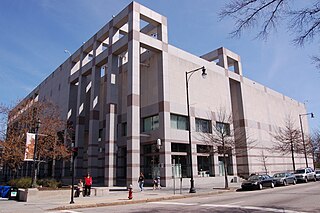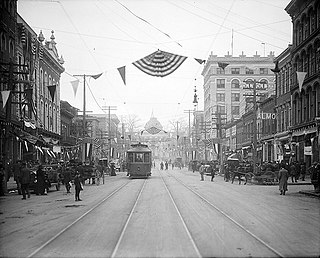
Durham is a city in and the county seat of Durham County in the U.S. state of North Carolina.
The U.S. Census Bureau estimated the city's population to be 251,893 as of July 1, 2014, making it the 4th-most populous city in North Carolina, and the 78th-most populous city in the United States. Durham is the core of the four-county Durham-Chapel Hill Metropolitan Area, which has a population of 542,710 as of U.S. Census 2014 Population Estimates. The US Office of Management and Budget also includes Durham as a part of the Raleigh-Durham-Chapel Hill Combined Statistical Area, which has a population of 2,037,430 as of U.S. Census 2014 Population Estimates.

WUVC-DT, virtual channel 40, is a Univision owned-and-operated television station licensed to Fayetteville, North Carolina, United States. Owned by the Univision Local Media subsidiary of Univision Communications, it primarily serves North Carolina's Triangle region, though it also targets the Charlotte, Greensboro, Greenville and Wilmington markets. WUVC's studios are located on Falls of Neuse Road in Raleigh, while its transmitter is located near Broadway.

The Carolina Theatre is a performing arts and cinema complex in downtown Durham, North Carolina. The facility is operated by a nonprofit organization named The Carolina Theatre of Durham, Inc. under a management agreement with the City of Durham, which owns the complex.

GoRaleigh is the transit system responsible for operating most of the public transportation services in Raleigh, North Carolina. The system operates 27 fixed routes throughout the city's municipal area and also operates five regional/express routes in partnership with GoTriangle, the regional provider. GoRaleigh is contracted to operate two additional routes, an express route to the Wake Tech Community College campus south of Raleigh and a local circulator service in the Town of Wake Forest. Capital Area Transit, also known as CAT, was rebranded to GoRaleigh in 2015 under the consolidated GoTransit, a joint branding of municipal and regional transit systems for the Greater Raleigh Metropolitan Region.

The National Capital Trolley Museum (NCTM) is a 501(c)(3) nonprofit organization that operates historic trolleys for the public on a regular schedule. It is located at 1313 Bonifant Road, Colesville, Maryland USA.

The North Carolina Museum of Natural Sciences (NCMNS) is located in Raleigh, North Carolina as the oldest established museum in North Carolina and the largest museum of its kind in the Southeastern United States. With about 1.2 million visitors annually, as of 2013 it was the state's most popular museum or historic destination among visitors.

An affiliate of the Smithsonian Institution,the North Carolina Museum of History is located in downtown Raleigh, North Carolina. Admission is free. Special programs include educational programs for children and families as well as craft demonstrations, music concerts, and other events for visitors and members. The Museum Shop features an assortment of North Carolina–made crafts and products. The museum is a part of the Division of State History Museums, Office of Archives and History, an agency of the North Carolina Department of Cultural Resources.

The Museum of the Albemarle is located in Elizabeth City, North Carolina. It serves as the northeastern regional branch of the North Carolina Museum of History. This area of North Carolina is sometimes considered the birthplace of English North America, with close proximity to Roanoke Island and the "Lost Colony" of 1585.
Marbles Kids Museum is a nonprofit children's museum located in downtown Raleigh, North Carolina in the Moore Square Historic District.

Fayetteville Street is a major street in downtown Raleigh, North Carolina, USA. It is a north-south thoroughfare that connects the State Capitol to the Raleigh Convention Center and the Progress Energy Center for the Performing Arts. It is the City of Raleigh's ceremonial center, hosting parades, special events, and seasonal celebrations.

The culture of San Antonio reflects the history and culture of one of the state's oldest and largest cities straddling the regional and cultural divide between South and Central Texas. Founded as a Spanish outpost and the first civil settlement in Texas, San Antonio is heavily influenced by Mexican American culture due to Texas formerly being part of Mexico and, previously, the Spanish Empire. The city also has significant German, Southern, and African American cultural influences. San Antonio offers a host of cultural institutions, events, restaurants and nightlife in South Texas for both residents and visitors alike.

The Omaha Children's Museum is a nonprofit learning and exploration space for young people located at 500 South 20th Street in downtown Omaha, Nebraska. The museum has received a national award from the Association of Science and Technology Museums.

The Maine Discovery Museum, located in Bangor, Maine, is Maine's largest children's museum and the largest located north of Boston, Massachusetts.

Peace College Main Building is the focal point of the Peace College campus in Raleigh, North Carolina. Built between 1859 and 1862, Main Building is located at the northern end of Wilmington Street in downtown Raleigh and is considered one of the largest antebellum buildings surviving in the city. During its early history, Main Building was used as a military hospital and offices for the Freedmen's Bureau. The building now contains offices, parlors, banquet rooms, and dormitory residences. Main Building was listed on the National Register of Historic Places in 1973 and is a designated Raleigh Historic Landmark.

The Fayetteville Street Historic District in Raleigh, North Carolina is a historic district listed on the National Register of Historic Places (NRHP). The District includes the 100-400 blocks of Fayetteville Street, the 00-100 blocks of the south side of West Hargett Street, the 00 block of the north side of West Martin Street, and the 100-400 blocks of South Salisbury Street.

Saint Mary's School is a private independent Episcopal college-preparatory, boarding and day school for girls in grades 9-11. Located in Raleigh, North Carolina, Saint Mary's School operates as an independent school with a historic association with the Episcopal Church including an Episcopal chapel, St. Mary's Chapel, on the school's grounds. The school formerly operated as Saint Mary's College and for many decades educated young women in grades 11-12 and their freshman and sophomore years in college. The school changed to a four year high school in 1998, at which point the name reverted to Saint Mary's School, the original name of the institution when it was founded in 1842.

The Fayetteville Historic Square, in Fayetteville, Arkansas, includes the original Fayetteville post office, the Old Bank of Fayetteville Building, the Lewis Brothers Building, the Mrs. Young Building, and the Guisinger Building. These buildings are listed in the National Register of Historic Places. There are several more recent buildings located on the Square.





















